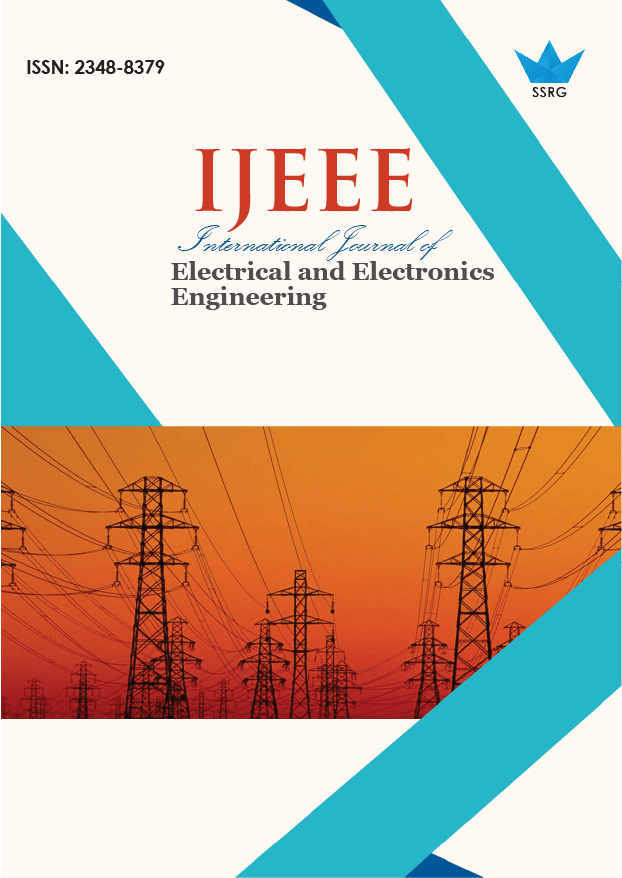Implementation of an Automatic Control System and an IOT Architecture for Wireless Monitoring Through Bidirectional Communication by RF and Wi-Fi for Registration in the Cloud of Parameters Needed in Greenhouse Operation

| International Journal of Electrical and Electronics Engineering |
| © 2025 by SSRG - IJEEE Journal |
| Volume 12 Issue 3 |
| Year of Publication : 2025 |
| Authors : Igor Miguel Paredes Cornejo, Estefany Jared Rojas Chacón, Fernando Paul Salazar Collantes, German Alberto Echaiz Espinoza, Andrés Ortiz Salazar, Elmer Rolando Llanos Villarreal |
How to Cite?
Igor Miguel Paredes Cornejo, Estefany Jared Rojas Chacón, Fernando Paul Salazar Collantes, German Alberto Echaiz Espinoza, Andrés Ortiz Salazar, Elmer Rolando Llanos Villarreal, "Implementation of an Automatic Control System and an IOT Architecture for Wireless Monitoring Through Bidirectional Communication by RF and Wi-Fi for Registration in the Cloud of Parameters Needed in Greenhouse Operation," SSRG International Journal of Electrical and Electronics Engineering, vol. 12, no. 3, pp. 202-222, 2025. Crossref, https://doi.org/10.14445/23488379/IJEEE-V12I3P119
Abstract:
Food shortages in Peru are frequently exacerbated by roadblocks due to social protests and seasonal variations, restrict food production, and intensify shortages, particularly in regions with limited cultivable land. To address this challenge, an automated control system and IoT architecture for wireless monitoring were developed to replicate specific climatic conditions within greenhouses, allowing the cultivation of crops typically restricted to certain regions and providing a potential solution to improve agricultural productivity and mitigate food scarcity. The system regulates critical environmental parameters such as temperature, irrigation and luminosity, while wireless monitoring of temperature, water level, luminosity, and pH is achieved through RF communication, with data transmitted to a database via Wi-Fi and visualized in real-time using a cross platform application. In addition, the NRF24L01 radio frequency communication modules were optimal for the application due to their ease of integration with the Arduino UNO development board, affordability, range, and market availability. The system was validated in a pilot-scale greenhouse. Further research is needed to evaluate its long-term scalability and efficiency in diverse agricultural settings, as these aspects remain critical to its broader applicability and impact.
Keywords:
Greenhouse, Automatic control, IoT, Radio Frequency, Monitoring.
References:
[1] National Disaster Risk Management Plan - PLANAGERD 2014-2021, National Center for Disaster Risk Assessment, Prevention, and Reduction (CENEPRED), 2021. [Online]. Available: https://sigrid.cenepred.gob.pe/sigridv3/documento/417
[2] Jorge Luis Chávez Cresta, Statistical Compendium 2017, National Institute of Civil Defense, gob.pe, 2017.
[Publisher Link]
[3] A. Perea Flores, ‘6-Friaje_Heladas’, Lima, 2018. [Online]. Available: https://www2.congreso.gob.pe/sicr/cendocbib/con5_uibd.nsf/322B8DD56F06DD6E0525832700584752/$FILE/6-Friaje_Heladas.pdf
[4] Juan Carlos Guillermo et al., “IoT Architecture Based on Wireless Sensor Network Applied to Agricultural Monitoring: A Case of Study of Cacao Crops in Ecuador,” International Conference of Information and Communication Technologies for Adapting Agriculture to Climate Change, Cali, Colombia, pp. 42-57, 2018.
[CrossRef] [Google Scholar] [Publisher Link]
[5] Leonardo Fernández Díaz et al., “Technological Architecture for Monitoring Environmental Variables in a Museum,” Colombian Journal of Advanced Technologies, vol. 2, no. 38, pp. 1-8, 2021.
[CrossRef] [Google Scholar] [Publisher Link]
[6] Haozhe Zhang et al., “Lorawan Based Internet of Things (Iot) System for Precision Irrigation in Plasticulture Fresh-Market Tomato,” Smart Agricultural Technology, vol. 2, 2022.
[CrossRef] [Google Scholar] [Publisher Link]
[7] Jalalu Guntur et al., “An Automatic Irrigation System Using IOT Devices,” Materialstoday: Proceedings, vol. 68, pp. 2233-2238, 2022.
[CrossRef] [Google Scholar] [Publisher Link]
[8] Jissie Vaquero López, and Carlos Luis Milian del Valle, “Nonlinear Control Using Approximate Linearization Applied in the Nonlinear System Position of a Ring on a Rotating Ring,” Cuban Journal of Computer Science, vol. 10, no. 2, pp. 89-99, 2016.
[Google Scholar] [Publisher Link]
[9] Rafael J. García et al., “Design of a Fuzzy Control Strategy Applied to the Ultra-Freezing Process of Food,” Ingeniare. Chilean Engineering Journal, vol. 25, no. 1, pp. 70-84, 2017.
[Google Scholar]
[10] Chiara Bersani et al., “Internet of Things Approaches for Monitoring and Control of Smart Greenhouses in Industry 4.0,” Energies, vol. 15, no. 10, pp. 1-30, 2022.
[CrossRef] [Google Scholar] [Publisher Link]
[11] R. Jimenez Moreno, O. Aviles Sanchez, and O.L. Ramos Sandoval, “Analysis of the Implementation of a Fuzzy Controller on Different Hardware Architectures,” Neogranadine Science and Engineering, vol. 23, no. 1, pp. 77-87, 2013.
[Google Scholar]
[12] Yongchao Song, Jiping Bi, and Xuan Wang, “Design and Implementation of Intelligent Monitoring System for Agricultural Environment in IoT,” Internet of Things, vol. 25, 2024.
[CrossRef] [Google Scholar] [Publisher Link]
[13] Dawid Witczak, and Sabina Szymoniak, “Review of Monitoring and Control Systems Based on Internet of Things,” Applied Sciences, vol. 14, no. 19, pp. 1-27, 2024.
[CrossRef] [Google Scholar] [Publisher Link]
[14] José de Jesús García Cortés et al., “Low-Cost Wireless System for Monitoring Temperature and Relative Humidity in a Greenhouse,” Ingeniantes, vol. 2, no. 2, pp. 61-67, 2019.
[Google Scholar]
[15] Mohammad Mansour et al., “Internet of Things: A Comprehensive Overview on Protocols, Architectures, Technologies, Simulation Tools, and Future Directions,” Energies, vol. 16, no. 8, pp. 1-39, 2023.
[CrossRef] [Google Scholar] [Publisher Link]

 10.14445/23488379/IJEEE-V12I3P119
10.14445/23488379/IJEEE-V12I3P119